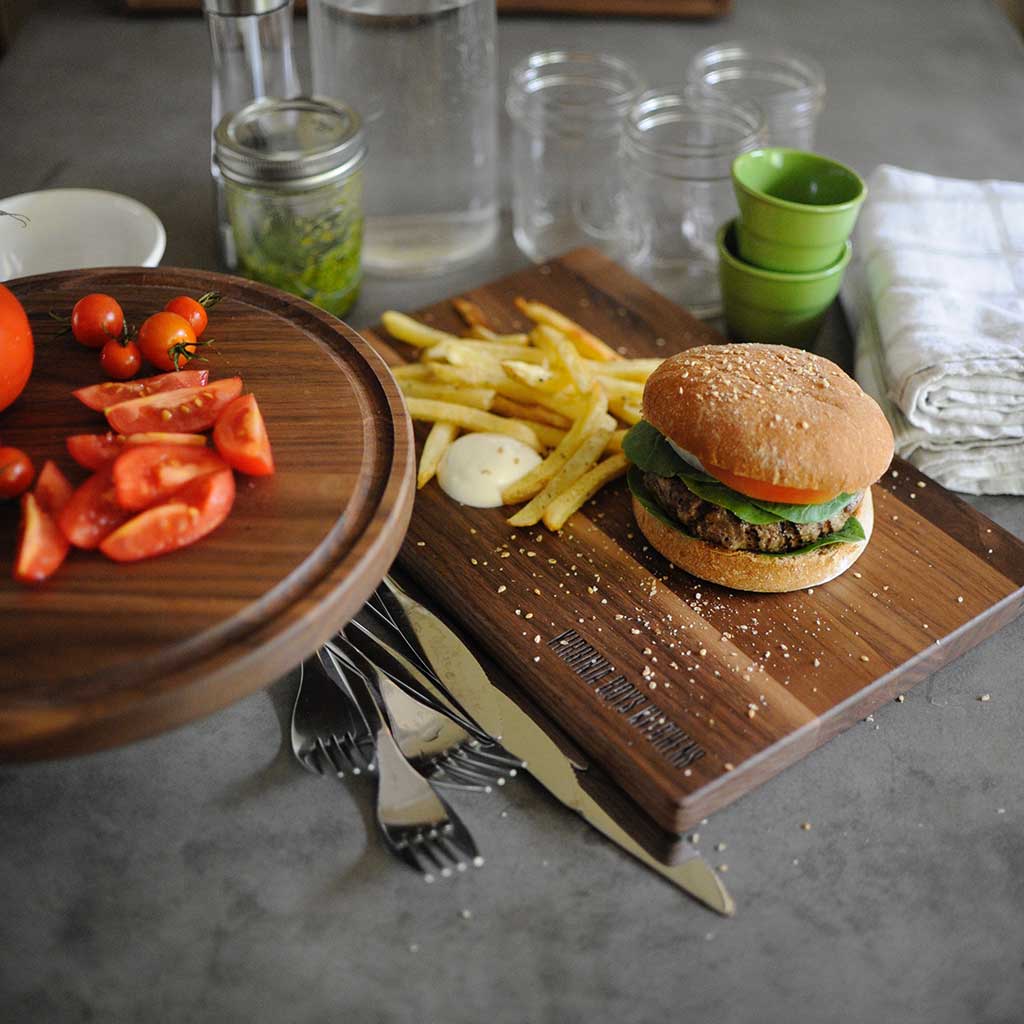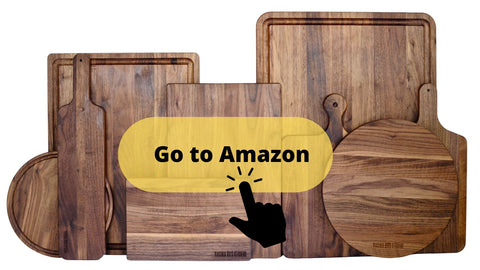Are you stuck trying to figure out the best wood for your cutting board? If so, you found the right article to help you.
Indeed, cherry and walnut are some of the best cutting board materials since they are highly durable, beautiful, and readily available. But which one is the best? This comprehensive comparison will compare everything you need to know about walnut and cherry cutting boards.
Note: the best type of cutting board may depend on what you are cutting. For example, read our article for the best cutting board for cutting meat if you plan to cook plenty of meat dishes!
| Aspect | Cherry Cutting Boards | Walnut Cutting Boards |
| Hardness Rating | Softer wood / Janka hardness rating 950 | Harder wood / Janka hardness rating 1010 |
| Toxicity | Non-toxic | Non-toxic |
| Wood Density | Medium density | Medium to high density |
| Porosity of Wood Grain | Tight grain pattern | Even grain pattern |
| Sustainability | Moderately sustainable | Moderately sustainable |
| Conditioning and Maintenance | Requires regular oiling | Requires regular oiling |
| Appearance | Warm reddish-brown with a subtle grain pattern | Deep brown with a pronounced grain pattern |
| Antimicrobial Properties | Mild antimicrobial properties | Strong antimicrobial properties |
| Versatility | Can be used for any food | Can be used for any food |
About Cherry Cutting Boards
Cherry wood is a hardwood with tight, smooth grain and a reddish-brown color. Cherry wood cutting boards are popular because of their impressive durability, non-toxicity, and softness that does not dull your knife. They also look great in any kitchen.
In fact, cherrywood, being a hardwood, has a Janka hardness rating of 950 pounds of force. With this hardness, it will last years in your kitchen, even with regular use. While this is hard, it is also somewhat soft for the sharp edges of your knife. This means it won't dull if you accidentally cut it when chopping food items.
Furthermore, cherrywood has a tight grain pattern. This makes it water-resistant while also remaining stain resistant. It is also resistant to warping and cracking over time. It will retain its shape with years of use.
About Walnut Cutting Boards
Walnut is a hardwood with rich brown color and even grain. Its smooth texture makes it easy for woodworkers to carve it and make beautiful items. Walnut wood is strong and durable, making it ideal for long-lasting cutting boards.
Perhaps a top reason walnut is used for making cutting boards is its resistance to wear and tear. For example, it can withstand regular use in a busy kitchen for years without showing aging signs, provided you do not swing your knife at it.
Walnut also has natural bacteria-resisting properties. Therefore, it's a relatively food-safe alternative as it is easy to sanitize after each use. It also has natural water-resisting capabilities. Consequently, it will not warp or crack even with years of use.
Regarding versatility, walnut cutting boards are suitable for almost any cutting, chopping, or slicing needs. You can even use it to serve appetizers, as the beautiful appearance adds a touch of sophistication to any table.
Cherry vs. Walnut Cutting Boards Comparison
Durability
Both cherry and walnut wooden boards are highly durable. However, walnut cutting boards, being harder, will often last longer than cherry wooden boards. However, it is important to remember that the durability of cutting boards largely depends on maintenance and care. With proper care and maintenance, a cherry-cutting board will last a long time.
Color and Grain
Fresh cherry wood has a warm reddish-brown color. The color often darkens with years of use. Walnut, on the other hand, has a deep brown color.
Maintenance
Cherry and walnut cutting boards require little maintenance since they only require occasional oiling to keep them in the best shape and color. Cherry is more susceptible to knife marks, so it requires more maintenance. Both boards will work with any food-grade oils, but a high-quality, fractionated coconut oil made specially for wood cutting boards will prolong the life of either board.
Cost
Cherry is more abundant in the US. Therefore, it tends to be cheaper and more available than walnut cutting boards.
Antimicrobial Properties
Both cherry and walnut cutting boards have some antimicrobial properties. Walnut, having an abundance of chemicals such as juglone, has better antimicrobial properties. In addition, the hard and dense wood means that there is no space for microorganisms to thrive.
On the other hand, cherry wood has weaker antimicrobial properties. However, it is better when compared to other materials such as glass or plastics.
Cherry vs. Walnut Cutting Boards: Which One Should You Buy?
Cherry and walnut cutting boards are some of the best in the market. They both have impressive durability, color, antimicrobial properties, and versatility. Therefore, choosing a clear winner in the cherry vs. walnut cutting boards debate is almost impossible but largely depends on individual properties.
Mainly the choice is made by color - cherry is more reddish whereas walnut is more of a rich brown chocolate hue.
Cherry vs. Walnut vs. Maple Cutting Boards
Maple, cherry, and walnut are the top materials to make cutting boards. However, each has its benefits and downsides.
If you're just now realizing that there are lots of great wood boards to choose from, don't be intimidated! We've got you covered with our complete guide to choosing the best wood for cutting boards to make sure you've got the right one for your kitchen!
| Aspect | Maple Cutting Board | Cherry Cutting Board | Walnut Cutting Board |
| Hardness Rating | Harder (1450 Janka rating) | Softer (950 Janka rating) | Hard (1010 Janka rating) |
| Toxicity | Non-toxic | Non-toxic | Non-toxic |
| Wood Density | High Density | Medium density | Medium to high density |
| Porosity of Wood Grain | Subtle grain pattern | Tight grain pattern | Even grain pattern |
| Sustainability | Sustainable and eco-friendly | Moderately sustainable | Moderately sustainable |
| Conditioning and Maintenance | Requires frequent oiling | Requires regular oiling | Requires regular oiling |
| Appearance | Light-colored with a subtle grain pattern | Warm reddish-brown with a subtle grain pattern | Deep brown with a pronounced grain pattern |
| Antimicrobial Properties | Mild antimicrobial properties | Mild antimicrobial properties | Strong antimicrobial properties |
| Versatility | Can be used for any food | Can be used for any food | Can be used for any food |
Hardiness
Firstly, maple is the hardest, with a Janka hardness rating of 1450. Indeed, it is the most durable option. Then, Walnut has a Janka rating of 1010, and cherry follows with a rating of 950. In any case, all these materials are ideal for making cutting boards.
Color
On the other hand, regarding the physical appearance: maple is light-colored, cherry is reddish brown, and walnut is deep brown. Overall, they are all a beautiful addition to any kitchen.
Antibacterial
Lastly, these hardwoods have some antimicrobial and water-resistant properties and can be used on almost any food item.
Frequently Asked Questions
Is cherry too soft for cutting boards?
Since it has a Janka hardness rating of 950, Cherrywood is perfect for making a cutting board. While some say it is too soft, it is important to know that softness can also be good. For example, a soft cutting board will be gentle on the sharp edges of your knife.
Which wood is harder: walnut or cherry?
Walnut has a Janka hardness rating of 1000, while cherry has a Janka hardness rating of 950. Consequently, walnuts are harder. Moreover, to provide context, the optimal Janka hardness score for a cutting board is between 900 to 1500. Undeniably, both are perfect for cutting boards.
Can I cut meat and vegetables from my cherry and walnut cutting boards?
Indeed, both walnut and cherry cutting boards are both highly versatile. You can use them for all your cutting, chopping, and slicing needs.
Conclusion
On the whole, cherry and walnut are the top materials to craft a beautiful cutting board. Both are highly durable and have moisture-resistant and antimicrobial properties. Mainly price and color is what determines which board you should go for. Cherry is reddish brown, and walnut is a rich chocolate hue.
RELATED PRODUCTS YOU MIGHT LIKE
View our entire collection of dark wood walnut reversible boards - there are many shapes and sizes to choose from. Find your perfect board for your next charcuterie or meal prep!
See Virginia Boys Kitchens On Amazon
We are on Amazon, see our storefront here. Use coupon code VBKBLOG10 for 10% off your entire purchase of any Virginia Boys Kitchens on Amazon. Apply the code at checkout.







